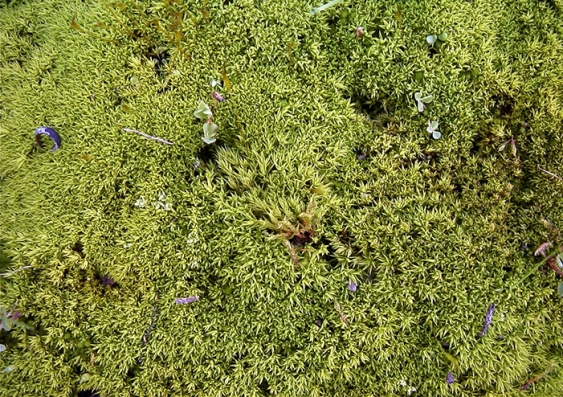Mosses Are A Vital Part Of The Health Of Soil And Earth
Some people see moss growing in their gardens as a problem, but what they may not realise is this ancient ancestor of all plants is bringing lots of benefits to our green spaces, such as protecting against erosion.
Now a massive global study led by UNSW Sydney has found mosses are not just good for the garden, but are just as vital for the health of the entire planet when they grow on topsoil. Not only do they lay the foundations for plants to flourish in ecosystems around the world, they may play an important role mitigating against climate change by capturing vast amounts of carbon.
In a study published today in the journal Nature Geoscience, lead author Dr David Eldridge and more than 50 colleagues from international research institutions described how they collected samples of mosses growing on soil from more than 123 ecosystems across the globe, ranging from lush, tropical rainforest, to barren polar landscapes, through to arid deserts like those found in Australia. The researchers found that mosses cover a staggering 9.4 million km2 in the environments surveyed, which compares in size to Canada or China.
“We were originally really interested in how natural systems of native vegetation that haven’t been disturbed much differ from human made systems like parks and gardens – our green spaces,” says Dr Eldridge, who is with UNSW’s School of Biological, Earth & Environmental Sciences.
“So for this study, we wanted to look at a bit more detail about mosses and what they actually do, in terms of providing essential services to the environment. We looked at what was happening in soils dominated by mosses and what was happening in soils where there were no mosses. And we were gobsmacked to find that mosses were doing all these amazing things.”
It turns out that mosses are the lifeblood of plant ecosystems, that plants actually benefit from having moss as a neighbour. The researchers assessed 24 ways that moss provided benefits to soil and other plants. In patches of soil where mosses were present, there was more nutrient cycling, decomposition of organic matter and even control of pathogens harmful to other plants and people.
On top of that, the authors say mosses may be instrumental in reabsorbing carbon dioxide. They estimated that compared to bare soils where there was no moss, this ancient precursor to plants is supporting the storage of 6.43 gigatonnes – or 6.43 billion tonnes – of carbon from the atmosphere. These levels of carbon capture are of a similar magnitude of levels of carbon release from agricultural practices such as land clearing and overgrazing.
“So you’ve got all the global emissions from land use change, such as grazing, clearing vegetation and activities associated with agriculture – we think mosses are sucking up six times more carbon dioxide, so it’s not one to one, it’s six times better,” Dr Eldridge says.
The researchers say that the positive ecological functions of soil mosses are also likely associated with their influence on surface microclimates, such as by affecting soil temperature and moisture.
What exactly is moss?
Mosses are different to vascular plants. They have roots and leaves, but their roots are different, with root-like growths called rhizoids that anchor them to the soil surface.
“Mosses don’t have the plumbing that an ordinary plant has, called a xylem and a phloem, which water moves through,” Dr Eldridge says.
“But moss survives by picking up water from the atmosphere. And some mosses, like the ones in the dry parts of Australia, curl when they get dry, but they don’t die – they live in suspended animation forever. We’ve taken mosses out of a packet after 100 years, squirted them with water and watched them come to life. Their cells don’t disintegrate like ordinary plants do.”
Without moss, our ecosystems would be in big trouble, says Dr Eldridge. He is amazed that people often see moss as a problem in urban settings when it’s actually playing an important role in nature.
“People think if moss is growing on soil it means the soil is sterile or has something wrong with it. But it’s actually doing great things, you know, in terms of the chemistry of the soil, like adding more carbon and nitrogen, as well as being primary stabilisers when you get lots of disturbance.”
He says when you lose moss through land clearing or natural disturbances, you lose the ability to hold the soil together, leading to erosion.
“And it means you’re going to lose nutrients, you’re going to lose habitat for microbes, the whole system becomes destabilised.”
Moss can even come to the rescue in disturbed ecosystems. Dr Eldridge points to research examining the area around the Mount St Helens Volcano following a devastating eruption in the early 1980s. Most of the flora and fauna was denuded near the eruption site, but researchers who tracked how life returned to the mountain noticed that mosses were among the first forms of life to reappear.
“The first things to come back were cyanobacteria, blue green algae, because they’re very primitive, and then mosses came back,” he says.
“What we show in our research is that where you have mosses you have a greater level of soil health, such as more carbon and more nitrogen. So they’re helping to prime the soil for the return of trees, shrubs, and grasses, that eventually end up getting out-competed in the process. So they’re the first guys that get in there and fix things up and then first to leave.”
Up next
Future research aims to examine whether urban mosses can create healthy soils as effectively as those growing in natural areas.
“We are also keen to develop strategies to reintroduce mosses into degraded soils to speed up the regeneration process,” Dr Eldridge says.
“Mosses may well provide the perfect vehicle to kick start the recovery of severely degraded urban and natural area soils.”

